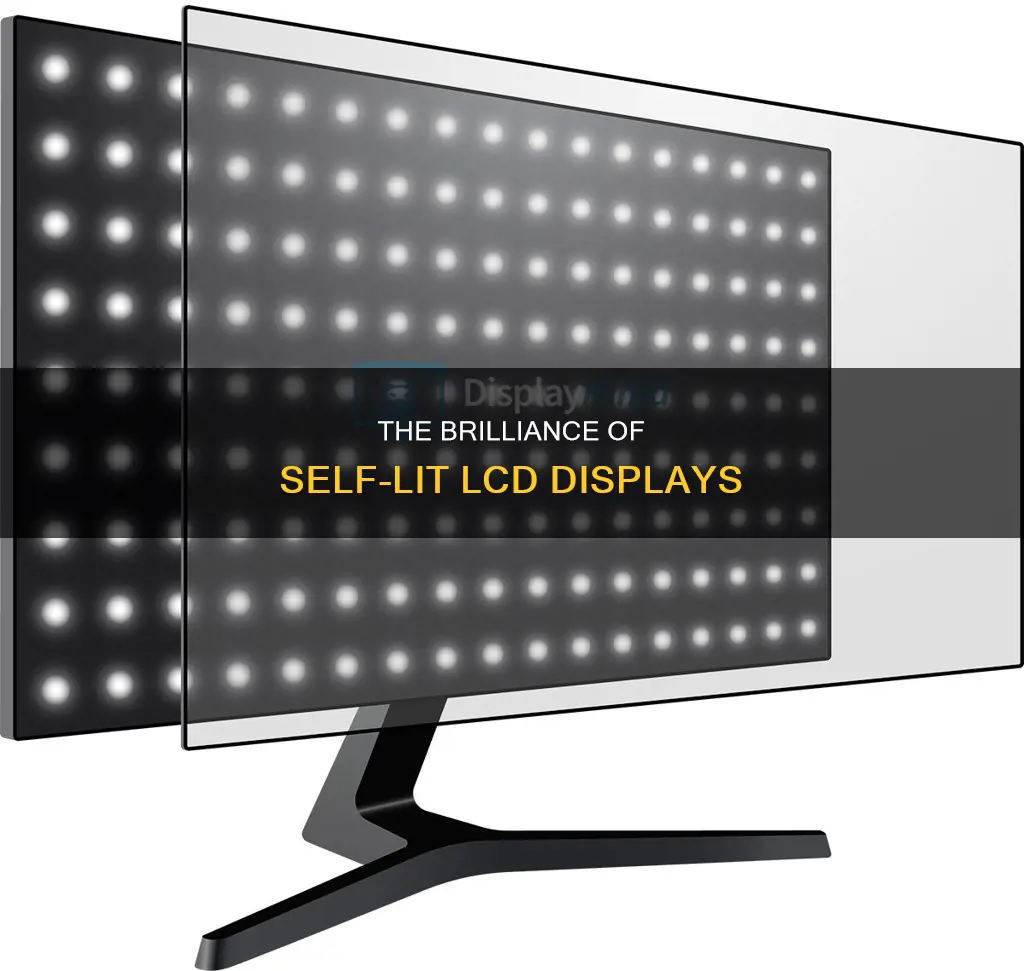
LCD stands for Liquid Crystal Display. LCD monitors do not produce their own light and require a backlight to produce a visible image. In the past, most LCDs were backlit with cold cathode fluorescent lamps (CCFLs). Now, most modern LCD monitors are lit with LEDs. LED monitors are a type of LCD monitor that uses light-emitting diodes (LEDs) for backlighting instead of traditional fluorescent lights.
What You'll Learn

LED monitors use light-emitting diodes for backlighting
LED monitors use light-emitting diodes (LEDs) for backlighting. This is in contrast to LCD monitors, which use cold cathode fluorescent lamps (CCFLs) for backlighting. In fact, all LED monitors are a type of LCD monitor, with the term "LED monitor" being shorthand for "LED-backlit LCD monitor".
LED monitors have several advantages over LCD monitors. They are thinner, more energy-efficient, and offer better contrast ratios and colour accuracy. They also have a longer lifespan, with LED backlights lasting 50,000 to 100,000 hours compared to 30,000 to 60,000 hours for CCFL backlights. Additionally, LED monitors provide more precise control over screen brightness and have better power management features.
There are two main types of backlighting used in LED monitors: full-array backlighting and edge lighting. Full-array backlighting involves placing LEDs evenly across the entire screen, allowing for local dimming and better contrast. Edge lighting, on the other hand, places LEDs only along the edges of the screen, resulting in thinner displays but potentially less uniform lighting.
LED backlights are also more energy-efficient, consuming significantly less power than other types of backlights. They are available in small sizes, allowing manufacturers to create smaller display devices with a slimmer profile. LED backlights also tend to last longer, with a reported average lifespan of 35,000 to 50,000 hours of continuous use. Furthermore, LED backlights produce less heat compared to other backlighting options, reducing the risk of fire.
In summary, LED monitors offer improved image quality, enhanced energy efficiency, and a longer lifespan compared to traditional LCD monitors with CCFL backlights.
Opening a Philips LCD Monitor: Step-by-Step Guide
You may want to see also

LCD monitors use cold cathode fluorescent lamps for backlighting
LCD monitors use cold cathode fluorescent lamps (CCFLs) for backlighting. CCFLs are long, thin tubes that produce light through the interaction of electricity with mercury vapour inside the tube. They are known for their long lifespan, high brightness, and low power consumption.
CCFLs were once the standard for backlighting in LCD monitors, but they have been largely replaced by light-emitting diode (LED) technology in recent years. LED-backlit LCD monitors offer several advantages over their CCFL predecessors, including reduced thickness, weight, and power consumption. Additionally, LED diodes last longer than CCFL bulbs.
Despite the shift towards LED technology, CCFLs still have some advantages. They provide more even backlighting, especially for larger displays, and they emit less blue light, which can help reduce eye strain. CCFLs are also more affordable than LED-backlit LCD monitors.
However, there are some drawbacks to CCFLs. They contain mercury, which can be harmful to the environment, and they have a shorter lifespan than LED backlights. CCFL backlights also require higher voltages and an inverter to function.
In summary, while LCD monitors with CCFL backlighting have been largely superseded by LED-backlit LCD monitors, they still offer some benefits in terms of even lighting and reduced eye strain. Nonetheless, the advantages of LED technology, such as longer lifespan, thinner design, and improved energy efficiency, have made it the preferred choice for most modern LCD monitors.
Monitoring Heating Oil Usage: Efficient Methods for Homeowners
You may want to see also

LED monitors are a type of LCD monitor
When shopping for a new monitor, you will often come across the terms LCD and LED. The main difference between the two lies in their backlighting technology.
LCD stands for Liquid Crystal Display. This technology uses liquid crystals, which are substances with properties of both liquids and solids, to create images on a screen. When an electric current is applied, the liquid crystals align to either allow or block light, thus creating the images you see on the display. LCD monitors are flat-panel displays that use liquid crystal technology to produce images. They are typically thinner and more energy-efficient than older CRT monitors, with good colour reproduction and brightness.
LED stands for Light-Emitting Diode. LED monitors are a type of LCD monitor that uses Light-Emitting Diodes (LEDs) for backlighting instead of traditional fluorescent lights. This is why the term "LED monitor" is shorthand for "LED-backlit LCD monitor". LEDs are basically very small bulbs, like mini Christmas lights. The arrangement of the LEDs behind the screen varies, with monitors featuring either full-array LED backlighting or edge lighting.
LED monitors offer superior picture quality with better contrast ratios and deeper blacks compared to LCD displays. LCD monitors can still provide good image quality but may struggle with producing true blacks. LED monitors are also more energy-efficient than LCD monitors, resulting in lower power consumption and reduced electricity bills over time. They also have a longer lifespan, with LED backlights typically lasting 50,000 to 100,000 hours compared to 30,000 to 60,000 hours for CCFL backlights in traditional LCDs.
In summary, while all LED monitors are a type of LCD monitor, not all LCD monitors use LED technology for backlighting.
Monitoring Employee Internet Usage: Privacy at Home?
You may want to see also

LCD monitors are flat-panel displays that use liquid crystal technology
LCD stands for Liquid Crystal Display. LCD monitors are flat-panel displays that use liquid crystal technology to produce images. They are available to display arbitrary images, such as in a general-purpose computer display, or fixed images with low information content. LCDs use the light-modulating properties of liquid crystals combined with polarizers to display information.
Liquid crystals do not emit light directly but instead use a backlight or reflector to produce images in color or monochrome. Each pixel on an LCD screen consists of three subpixels (red, green, and blue). Light passes through the liquid crystals and color filters to create the image you see on LCD screens.
LCD monitors are typically thinner and more energy-efficient than older CRT monitors. They also offer good color reproduction and brightness. LCD monitors historically used CCFL backlighting but now commonly use LED backlighting.
LED-backlit LCDs use the same TFT LCD technologies as CCFL-backlit LCDs but offer a range of advantages, including:
- Wider color gamut and dimming range
- Greater contrast ratio
- Very slim and lightweight design
- Lower power consumption and longer lifespan
While LED monitors have many advantages, LCD displays can be a better option in certain cases:
- Cost: LCD monitors are often more affordable.
- Matte screens: LCD monitors typically have matte screens, which reduce glare in bright environments.
- Consistent lighting: LCDs often have more uniform backlighting across the entire screen.
- Less blue light: LCD monitors emit less blue light, potentially reducing eye strain.
Monitoring Internet Usage on Your iPhone: A Step-by-Step Guide
You may want to see also

LED monitors offer superior picture quality and colour accuracy
LED monitors use light-emitting diodes (LEDs) for backlighting, while LCD monitors use cold cathode fluorescent lamps (CCFLs). LEDs are placed evenly across the entire screen, allowing for local dimming and better contrast. LCD monitors, on the other hand, often have more uniform backlighting across the entire screen.
The use of LED backlighting technology gives LED monitors superior LED displays with easier maintenance, better colour accuracy, and improved visual clarity. High-end LED monitors can display a larger percentage of the sRGB and Adobe RGB colour spaces, making them ideal for professionals in graphic design, photo editing, and video production.
LED monitors also have faster response times, reducing motion blur and ghosting. This makes them a better choice for gaming, especially for FPS gamers who want to compete at a high level.
In addition, LED monitors often have a longer lifespan than LCD monitors due to their more durable backlighting technology. LED backlights typically last 50,000 to 100,000 hours, while CCFL backlights in LCDs last around 30,000 to 60,000 hours.
LCD Monitors: Creating Color with Light and Crystals
You may want to see also
Frequently asked questions
LED (Light Emitting Diode) and LCD (Liquid Crystal Display) refer to different aspects of monitor technology. All LED monitors are a type of LCD monitor, using light-emitting diodes for backlighting.
An LCD monitor uses liquid crystal technology to produce images. It requires a backlight or reflector to illuminate the screen as it does not produce its own light.
An LED monitor is a type of LCD monitor that uses light-emitting diodes for backlighting instead of traditional fluorescent lights. LED monitors have superior picture quality, better energy efficiency, and longer lifespans than standard LCD monitors.
There are two main types of LED backlighting: full-array backlighting and edge lighting. Full-array backlighting allows for local dimming and better contrast, while edge lighting results in thinner displays.
LED-backlit LCDs offer a wider color gamut, greater contrast ratios, slimmer and lighter designs, lower power consumption, and longer lifespans than traditional CCFL-backlit LCDs.







